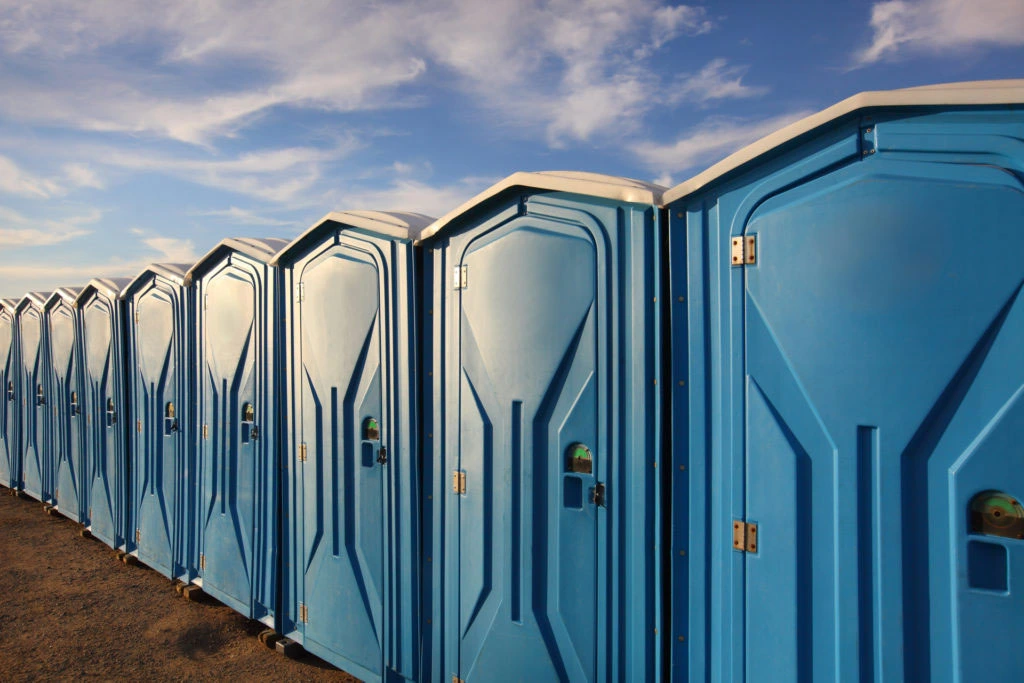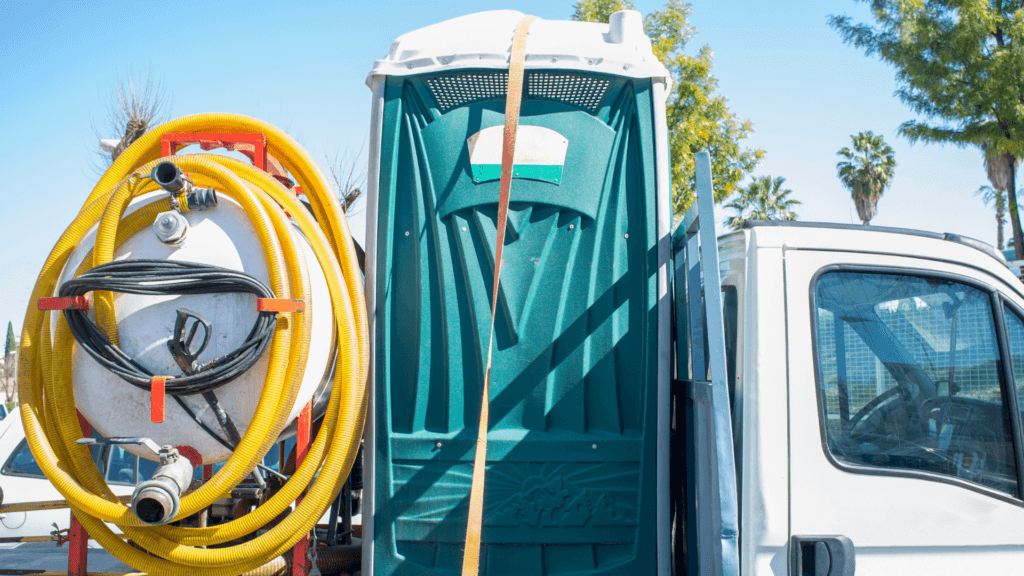How To Start A Portable Sanitation Business: Learn From The Best PROs And Their Mistakes

So you’ve decided to explore starting your own portable sanitation business. Congratulations! The exploration phase is the first part of an exciting journey that can lead to more freedom and satisfaction in your personal and professional life.
Because the portable sanitation business directly serves rapidly growing sectors, it’s an industry with plenty of opportunities for long-term success. In early 2023 it was reported that total employment in the construction industry had increased by 231,000, or 3.1%, compared to the same month in the previous year. And with portable sanitation being one of the biggest (and often overlooked) needs on a construction site, you can take advantage of this increase.
A portable restroom business is a great option for those who value freedom, hard work, and results. As your own boss, you’ll determine when and how much you work, whom you work with, and have the potential to earn a steady, sustainable income. Portable restroom business operators work closely with community partners to provide safe and reliable on-site restroom facilities for events, construction sites, and more.
Before you jump into buying equipment and reaching out to potential customers, there are some important first steps to consider.
1. Create a Business Plan for Portable Restroom Business

Without a plan, you’re just throwing spaghetti at the wall to see what sticks. A business plan allows you to put the time and research in before you start to build and know exactly who you serve, what your best approach is, and where to invest resources. A business plan typically includes the following elements.
Executive Summary
The executive summary briefly states what your business is, the products or services it provides, and why it will be successful. You may also want to include a values or mission statement, along with a high-level overview of the leadership team.
Company Description
This is where you’ll dive into deeper details of your business. It will address the problems your business will solve for customers, what gives your new business a competitive advantage and any other strengths you wish to share. This may include your past experience, expertise, or anything else that positions you to serve customers above and beyond the competitors. Go ahead, brag a little!
Market Research
Most people see the word “research” and run in the opposite direction, but this form of research doesn’t have to be scary or take months to gather. It’s extremely valuable to get an idea of what potential customers are looking for and what your competitors are doing well. It will help paint a picture of the trends, themes, strengths, and weaknesses in your market, plus shine a light on where your business can fill the gaps.
Organization and Personnel
This part of the plan will outline the structure of your company, the personnel you’ll need to bring on board and the chart of where each role fits into the overall team. It’s also the place where you’ll identify what type of business you’ll have: a sole proprietorship, an LLC, a corporation and so on. If you’re not sure what type of business makes sense for you, a lawyer should be able to explain your options.
Marketing Strategy
You don’t have to have all the parts of your marketing strategy defined and you may change this section at any time to address the needs of your business as it grows. This section is simply an area to describe how you’ll attract and maintain customers. It may include tactics like social media marketing, advertisements, or public relations.
Financial Projections
Again, your financial projections in this section don’t have to be exact, but the purpose is to convince the reader that your business is stable and will be a financial success. If your business is already established, you will want to include existing financial statements to support your projections, like income, cash flow, and balance sheets. If you don’t have these yet, a projection with a detailed explanation should be included.
A business plan can be as complex (traditional) or simple (lean startup) as you want it to be. For larger organizations or for those requesting outside funding, a more detailed plan may be required.
During your research and planning phase, you’ll want to examine things like standard ROI, pricing, and expenses. The highlight of beginning a portable sanitation business is that you can expect a return on your investment in just 24 to 36 months from a cold startup, which is also great news to share with potential investors.
Next, it’s time to plan your pricing structure. How will you price your units? This is an important piece to research while doing market analysis. How does your competitor price their units? What’s the typical cost for this type of service in your region?
To determine the cost per service, you will need to calculate the cost of fuel, labor, and supplies for each service and divide it by the number of toilets serviced per hour or day.
Cost per service = (Fuel cost per service + Labor cost per service + Supplies cost per service)/Number of toilets serviced per hour or day
To calculate the standard expenses, add up the costs for fuel, paper goods, chemical supplies, fleet maintenance, disposal fees, and overtime labor costs. Ideally, the total amount of expenses should be less than 30.5% of your total revenue.
Standard Expenses = Fuel Cost + Paper Goods Cost + Chemical Supplies Cost + Fleet Maintenance Cost + Disposal Fees + Overtime Labor Costs
To calculate your monthly margins, multiply the cost per service by the number of services in a month and subtract it from your monthly revenue from one customer. This will give you the amount of profit you are making per customer each month.
Monthly Margins = Monthly Revenue – (Cost per Service x Number of Services in a Month)
2. Identify your target market and what services you wish to provide
There’s a variety of client segments your portable sanitation business can choose to focus on, from commercial construction to special events. This decision may reflect the type of businesses you want to serve or it may be based on top revenue generators.
Note that in 2022, the most profitable portable restroom business customers came from the home builder and commercial categories. Residential construction includes home builders as well as home projects, like swimming pool installation. Commercial construction includes apartments, high-rise buildings, schools, and other larger projects.
Whichever segment you choose to focus on, be sure to consider factors like seasonality, rates, cleaning, and the amount of equipment each job will require. These will all affect your bottom line.
After everything above, it’s time to decide what services you will offer. Portable sanitation covers a lot of territories. These are just a few options you might want to include under your offer umbrella.
- Portable restrooms (there are many variations of size, shape, capabilities, and accessibilities)
- Hand washing stations
- Sanitizing stations
- Restroom trailers
- Septic trucks
- Dumping services
Once you determine what services will be available to your customers, it’s time to think about how you’ll pay for equipment.
3. Financing a Portable Restroom Business
The question on most people’s minds when they think about launching a business is, “How much money will I need to get started?” The number may vary depending on each unique situation, but generally, having access to $350,000 will ensure a smooth beginning. This amount will get you two trucks, 100 toilets, and 30 days of supplies.

We get it — that is a lot of money, but there are several avenues to explore when securing startup funding. The best funding source will depend on whether you need it for large purchases, day-to-day expenses, or startup costs.
- US Small Business Administration loans. This may be an option if your business is small to moderate size and meets qualifications. SBA loans are traditional term loans that you pay back over time with interest. SBA-guaranteed loans generally have rates and fees that are comparable to non-guaranteed loans, plus lower down payments, flexible overhead requirements, and no collateral needed for some loans.
- Online lenders. These lenders provide small business loans and lines of credit of up to $500,000. The APR on these loans ranges from 6% to 99%, depending on the lender, the type and size of the loan, the length of the repayment term, the borrower’s credit history, and whether collateral is required.
- Business lines of credit. If you’re looking for funding for day-to-day expenses, you may want to look into a business line of credit. Many credit card companies offer these, along with banks. Be sure to research your options before committing to one, as each will have its own unique set of rules, regulations, and interest rates.
Not all business expenses need to be funded by an outside source. If you have access to cash flow that can be applied to your business, you can take advantage of smaller loans with less risk.
When planning the finances of your portable sanitation business, don’t forget to open a business bank account. We recommend reaching out to a local banker who can act as your connection point for any financial questions that may arise as you launch your business. A close banking relationship can go a long way.
4. Legalities of Starting a Portable Restroom Business
Though it can be tempting to launch your business before you have all the proper documentation set, resist the urge! There is nothing riskier for a new business than stumbling into some bad luck, forgetting an important piece of paperwork or insurance coverage, and being hung out to dry with no protection. Don’t neglect these important factors.
- Licensure. What licenses do you need to operate this type of business in your particular area of the US?
- Permits. Similarly, what type of permits are required by your state, county, or region to operate legally?
- Insurance. Never go into business without insurance coverage. You may want to consider both business insurance and fleet insurance for your portable restroom business.
- Get educated. As a portable service provider, you will need to know and abide by the local dumping laws and procedures. Some wastewater disposal facilities require both specific licensing and an account to do business. Some disposal sites measure by truckload capacity while others by solid waste measurement, etc. It never hurts to contact your local wastewater disposal sites and learn about their unique requirements.
It can feel overwhelming to ensure all of these items are in place before opening for business but we assure you, it is worth doing the right way and will save you from future headaches.
5. What do you need to get started with your portable sanitation business?

The most important component of starting a portable sanitation business? The equipment, of course! There is a range of portable restroom options to consider adding to your inventory– whether leased or owned. These are the main types of toilets.
- Standard portable toilet. The most common option is great for large-scale events and job sites where many toilets are needed.
- ADA- accessible toilet. A handicap-accessible portable toilet is similar to the standard, but larger and wider to meet ADA compliance. It’s wise to have one or several of these in your lineup.
- Portable toilet with sink. In the post-pandemic world, users appreciate having access to a handwashing station after using the facilities, so this is a good option to consider.
- Portable toilet with a baby changing table. Do you plan to serve family-friendly events or customers? This is an important option to offer.
- Flushable toilet. Unlike the standard portable toilet, this restroom includes a flushing feature. This option is great for more intimate events like outdoor weddings.
Before deciding on your toilet inventory, do your research and think 18 to 36 months in the future. What types of customers will you serve? Is there a peak season for your clientele? What type of events do you plan to focus on? You’ll also want to think about how much inventory you need to properly serve your client sector.
More tips to get started
- Research manufacturers — the quality of their products, their status in the supply chain, and any guarantees or warranties that accompany their toilets.
- Here are a few manufacturers that partner with ServiceCore:
- It’s generally recommended to have 3 hand washing stations for every 10 toilets in your inventory (assuming you don’t have sinks included in each restroom.)
- Don’t forget to account for supply chain issues across the board– which includes toilet paper, deodorizer, paper towels, and soap. Without reliable access to these “accessories,” you can’t run a successful portable sanitation business.
- Have you thought about storage? Where will you store your equipment when it’s not in use? How much will that cost annually?
These factors should all tie into your business plan.
6. Common Processes of Portable Restroom Businesses
Processes are at the core of every successful business, and with good reason. Processes are the scaffolding that keeps your business on top of things like billing, payroll, accounting, and customer service best practices. Let’s start with making and receiving payments.
You’ll want to determine your billing and invoicing process from the get-go. We highly recommend setting up a credit card payment option to avoid always having to wait on and process checks from customers. In 2023, many businesses prefer a cashless payment option. Make sure to factor in any processing fees or deductions by the provider.
Next, create an invoicing guideline that is the same across the board. This will eliminate having to get customers on the same page. If everyone is invoiced with the same payment cycle, that becomes your expectation. There is less room for negotiation or confusing process changes. Be mindful that some customers may ask for Net 60 or Net 90, but research found that the most profitable survey respondents are billing their customers upfront, on a 28-day cycle, and keep their accounts receivable under 60 days outstanding.
When invoicing, it’s advisable to request as much payment upfront for an event as possible– at least 25-50% of the total bill. This practice can save your business a lot of hassle or chasing after an event is over, something neither you nor your customer should have to worry about. It’s also best to avoid having an on-call staff member handle cash from weekend or off-hours events. It’s too risky.
By establishing your invoicing and payment policies right away, everyone will be on the same page, and operations will run more smoothly.
Staffing is nearly as important as the business itself, as your staff will become the face and reputation builders for your portable sanitation business. You’ll need to consider:
- How many drivers to hire
- How many service technicians to hire
- Positions to fill, including operations manager, delivery and pickup driver, yard technician, and sales.
Don’t skimp on front-end personnel. Customer service should be a large focus as you build your team. These are the folks who will keep things running even when you’re not there. Consider utilizing technology to streamline your customer service processes (incoming calls, appointments, reservations, etc.) It’s a great way to streamline workflows without adding to the overall headcount.
Route management is essential when it comes to portable sanitation. It’s generally better to structure 10-hour days vs. 7 or 8. Overtime is typical in this industry, so it can be helpful to have more wiggle room in your daily schedule. It takes time for trucks to be loaded, fuel up, and get on the road. If your route is not optimized, there is too much leeway for wasted time or off-the-books coffee breaks from your drivers. This is another area where software can save you time and money in the long run.
7. Partnerships You’ll Want to Create as Portable Restroom Operator

Despite what you may have been taught, it’s actually a good thing to build relationships with your competition. This industry is quite collaborative, so you may find yourself looking for assistance or providing assistance to someone in your local portable restroom business circle. As you’re getting started, it’s helpful to have shared access to equipment that you can rent from a partner. Once you’re established, you might do the same for another business. We are believers in the old phrase, “What goes around comes around!”
Becoming friendly with your competitors will also allow you to learn more about the pricing structure in your area. If you’re all pricing services approximately the same, you can rise together and eliminate lowballers. Everyone benefits and becomes stronger together.
8. Marketing Your Portable Restroom Biz Like a PRO
Business owners often get nervous about the idea of marketing their business, especially if they’re not experienced in sales. Marketing is just a fancy way of saying, “This is how we will attract customers.” There are so many different avenues to explore while marketing your new portable sanitation business. Choose one or a few that complement each other and work within your marketing budget.
The first step to marketing your business is to brand yourself. Who are you? What do you stand for? What are your values? Who do you serve? How do you serve? What is your logo, brand colors, and marketing tone of voice? Once you establish these elements– stick to them. It will build brand recognition. Identify what makes your business unique or better than the competition and make it part of your identity.
Whenever possible, get your name out there. This can mean putting flyers in local business establishments, through the chamber of commerce in your town, rotary club, or volunteering for community events. (This is also a nice way to show your values to potential customers.)
As your brand begins to grow, you can make the most of free marketing tools like social media and networking. You may be surprised by how effective these tactics can be when you show up consistently.
Also, consider paid marketing through direct mail, online advertising, print advertising, and PR via television and radio. Are there industry-appropriate events you can sponsor to get your name out there? How about participating in a tournament at a fundraiser or brewery? Anytime you can think outside the box for your marketing, you’ll catch the attention of more potential customers.
If you are working in a specific sector like construction or special events, make an effort to build relationships with event venues and government agencies. Many of these organizations will put out RFPs (requests for proposals) that you can apply to. Check websites for a published calendar of opportunities.
Treat your new business like a new baby or pet. Growth takes time, effort, and patience but the payoff is well worth it!
Do you want more people to visit your website? How about more paying customers? Make your website a quote-generating machine with these tips! Click here.
Best practices for portable sanitation businesses
Now that you have a solid strategy for launching your new portable sanitation business, let’s explore some general best practices tried and true within the industry. Some of these may seem like common sense, but we know it can be overwhelming, considering everything you need to know to be successful.
- Cleanliness: Here are some rules of thumb for ensuring your service is up to standard.
- Your team should be able to service 5 units per hour.
- Identify how you want the toilets cleaned to minimize the number of trips from the truck back to the unit. This makes it the most efficient process for your service tech.
- Clean units the same way every time with the same thoroughness. Your reputation is at stake.
- Identify service frequency. How many times will you service per week?
- Honesty: Don’t market yourself as having a restroom trailer until you have it. Then and only then, push into those markets and opportunities when you do.
- Don’t oversell your inventory: By using an inventory management system, you’ll be able to more accurately forecast what your client needs will be in the months ahead.
- Mix up your services: It’s okay to specialize in one area but also experiment in various sectors. It’s also smart to diversify your services. What else can compliment your portable restrooms? Portable fencing is one such idea.
Once your business is up and running, you’ll want to start to think of new and innovative ways to continuously improve client experience, add value, and increase revenue. Here are some questions to ask and plan for.
What’s next?
- How do you protect your business as it grows? Additional insurance?
- Identify what inventory you need to continue to fund growth
- Examine route efficiency
- Set a plan for managing difficult customers
- Brainstorm the most efficient way to scale– it might include adding additional accounts to maximize density.
- Plan for unexpected challenges like challenging customers, bad terrain, and unsafe circumstances.
If you’ve been in the portable sanitation business for some time, what tips and tricks can you share? Your insights are so valuable and appreciated!
Want help growing your portable restroom business?
Consider ServiceCore to help with route optimization, inventory management, automated billing, customer/job management, and more. Click here to schedule a demo.



